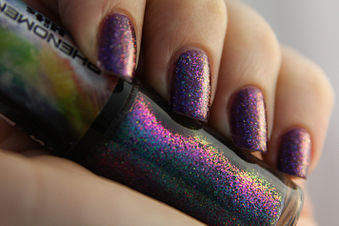Glitter

Glitter describes an assortment of small, flat, reflective particles. Glitter particles reflect light at different angles, causing the surface to sparkle or shimmer. Glitter is like confetti, sparkles, or sequins, but somewhat smaller. Since prehistoric times, glitter has been made and used as decoration, from many different materials including stones such as malachite,[1] galena,[2] mica,[3] insects,[4] and glass. Modern glitter is usually manufactured from plastic.
Modern glitter
The first production of modern plastic glitter is credited to the American machinist Henry Ruschmann, who found a way to cut plastic or mylar sheets into glitter in 1934.[3] During World War II with German glass glitter unavailable, Ruschmann found a market for scrap material ground into glitter made of plastics.[3][5] He founded Meadowbrook Inventions, Inc. in Bernardsville, New Jersey, the company is still a producer of industrial glitter.[6] Decades later he filed a patent for a mechanism for cross-cutting films as well as other related inventions.[7]
Today over 20,000 varieties of glitter are manufactured in a vast number of different colors, sizes, and materials.[8] Over 10,000,000 pounds (4,500,000 kg) of glitter was purchased between the years of 1989 and 2009 alone. Commercial glitter ranges in size from 0.002 square inches (1.3 mm2) to 0.25 square inches (160 mm2).[9] First, flat multi-layered sheets are produced combining plastic, coloring, and reflective material such as aluminium, titanium dioxide, iron oxide, and bismuth oxychloride. These sheets are then cut into tiny particles of many shapes including squares, rectangles, and hexagons.[9]
Ancient glitter

Glittering surfaces have been found to be used since prehistoric times in the arts and in cosmetics. The modern word “glitter” comes from glitra in Old Norse through Middle English. However, as early as 30,000 years ago, mica flakes were used to give cave paintings a glittering appearance.[3] Prehistoric humans are believed to have used cosmetics,[10] made of powdered hematite, a sparkling mineral.[11]
8,000 years ago people of the Americas were using powdered galena a form of lead, to produce a bright greyish-white glittering paint used for objects of adornment.[2] The collecting and surface mining of galena was prevalent in the Upper Mississippi Valley region by the Cahokia native peoples, for regional trade both raw and crafted into beads or other objects.[2]
Over 6,000 years ago, ancient Egyptians produced glittering cosmetics from the iridescent shells of beetles[4] as well as finely ground green malachite crystal.[1] Researchers believe Mayan temples were sometimes painted with red, green, and grey glitter paint made from mica dust, based on infrared scans of the remnants of paint still found on the structures in present-day Guatemala.[12]
Prior to modern plastics, particles of glass were used to create glittering surfaces and glass glitter is still produced commercially.
Uses
Prior to fabrics made with modern glitter, sequins were sewn or woven on to fabric to give it a glittering appearance. Edible glitter made from gum arabic and other ingredients is even used by culinary artists.[13]
Glitter is used in cosmetics to make the face and nails appear more shiny or sparkly. Additionally, it is used in children's arts and crafts to color and texture items. The small, brightly colored particles often stick to clothing, skin, and furniture, and can be a hassle to remove.
Due to its unique characteristics, glitter has also proven to be useful forensic evidence. Because of the tens of thousands of different commercial glitters, identical glitter particles can be compelling evidence that a suspect has been at a crime scene. Glitter particles are easily transferred through the air or by touch, yet cling to bodies and clothing, often unnoticed by suspects.[14]
Glitter coatings or finishes are frequently used on fishing lures to draw attention by simulating the scales of prey fish.[15]
Glitter is also used in glitter bombing, which is an act of assault in which activists throw glitter on people at public events. Glitter bombers have frequently been motivated by, though not limited to, their targets' opposition to same-sex marriage. Some legal officials argue glitter bombing is technically assault and battery.
References
- ^ a b "Ancient Egyptian Eye Makeup". Country Facts. Retrieved November 12, 2012.
- ^ a b c Gibbon, Guy E. (August 1, 1998). Ames, Kenneth M. (ed.). Archaeology of Prehistoric Native America: An Encyclopedia. Routledge. p. 310. ISBN 978-0815307259.
- ^ a b c d Mangum, Aja (Oct 7, 2007). "Glitter: A Brief History". New York Magazine. Retrieved 2013-10-12.
- ^ a b "Beauty, Hairstyles and Cosmetics in Ancient Egypt". Facts and Details. Retrieved November 12, 2012.
- ^ "10,000,000 pounds of glitter was purchased between 1989 and 2009. All That Glitters: The History of Shiny Things". Etsy.com. Retrieved November 12, 2012.
- ^ "Company Information". Meadowbrook Inventions, Inc. Retrieved November 12, 2012.
- ^ "Operating upon sheets of foil — US 3156283 A".
- ^ "90 Seconds with Meadowbrook". Meadowbrook Inventions, Inc. Retrieved November 12, 2012.
- ^ a b "Glitter and Sequins Sizing and Shaping". Meadowbrook Inventions, Inc. Retrieved November 12, 2012.
- ^ "Neanderthal 'make-up' containers discovered". BBC News. January 9, 2010. Retrieved September 22, 2013.
- ^ "The History of Glitter". Auntie Illumi. Retrieved November 12, 2012.
- ^ Hansford, Dave (February 7, 2008). "Ancient Maya Used "Glitter" Paint to Make Temple Gleam". National Geographic. Retrieved December 12, 2013.
- ^ "Watson Inc. - Edible Glitter". Retrieved 2013-10-12.
- ^ "Glitter as Forensic Evidence" (PDF). NFSTC. Retrieved November 12, 2012.
- ^ "Fishing lure — Patent US 2547240 A".


